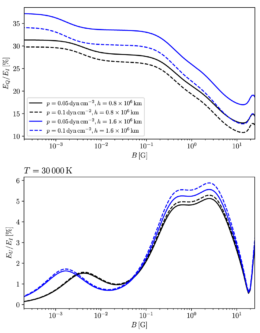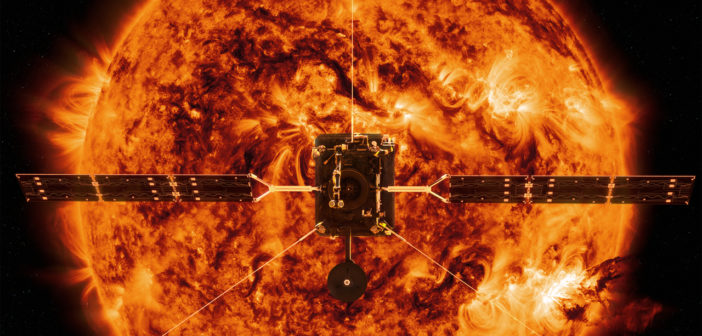The European Space Agency–NASA Solar Orbiter was launched at the start of 2020 to study the Sun and its influence on the solar system. One of its instruments, Metis, has the ability to study the immediate surroundings of the Sun. Could Metis soon provide a new window into coronal mass ejections?

A coronal mass ejection as seen by two coronagraphs (orange: LASCO C2, blue: LASCO C3) on the Solar and Heliospheric Observatory on February 27, 2000. [ESA & NASA/SOHO]
Mysterious Magnetic Fields Meet Their Match?
Coronal mass ejections (CMEs) are massive releases of magnetized plasma from the Sun’s surface. They are highly energetic and move extremely fast, sometime at millions of miles per hour. CMEs likely originate from interactions within the Sun’s complex magnetic environment, but there still remains a lot to be learned about them.
To study magnetic fields in the Sun, we can use a tool called spectropolarimetry to examine the polarization of certain wavelengths of light. Polarization is key here: it is the measurement of these oscillations in electromagnetic waves that allow us actually probe magnetic fields. Until now, CMEs have never been studied in this way — but that might change very soon!
The Metis instrument on the Solar Orbiter is a coronagraph; it is built to study the Sun’s corona at visible light and ultraviolet wavelengths simultaneously. Notably, Metis’s capability in visible light could allow it to measure the polarization of the D3 emission line, which is associated with helium. In a study, a group of researchers led by Petr Heinzel (The Czech Academy of Sciences, Czech Republic) examined how well Metis could observe this D3 line in the context of CMEs as well as what we could learn from those observations.

Fractional polarization signals EQ/EI (top) and EU/EI (bottom) versus magnetic field strength intensity at a temperature of 30,000 K. The contributions of the D3 line and visible light are both included. The dashed and solid lines correspond to combinations of different heights from the solar surface and plasma pressures. [Adapted from Heinzel et al. 2020]
Reading Between the Lines
Heinzel and collaborators first modeled CMEs and determined how the D3 line could be produced. Then, they considered how the D3 line would appear to Metis. At temperatures between 30,000 K and 50,000 K — very attainable for CMEs — the intensity of the D3 line is much greater than the intensity of the rest of the visible light wavelengths available to Metis. However, the polarizations associated with these two components of the visible light observations are all tangled up with each other. So what now?
The polarization of the D3 line will be affected by the CME magnetic field, and so the total observed polarization will change with magnetic field strength (and other relevant factors). These changes are very evident when we compare the intensities of different polarization parameters. Interestingly, the contribution of the D3 line can result in “depolarization”, or the lowering of certain polarization parameters.
So will Metis be able to tell us about the magnetic fields of CMEs? It’s likely! The authors of this study plan to do more detailed analysis on how CME features will affect what Metis can see, and if we can bring Metis’s ultraviolet capabilities into this science. They also note the exciting prospect of combining Metis’s data with those from the upcoming Proba-3 mission. Perhaps the mystery of CME magnetic fields won’t stay a mystery for long!
Citation
“On the Possibility of Detecting Helium D3 Line Polarization with Metis,” Petr Heinzel et al 2020 ApJ 900 8. doi:10.3847/1538-4357/aba437

